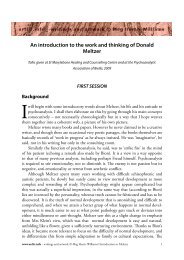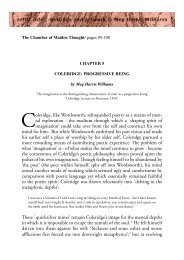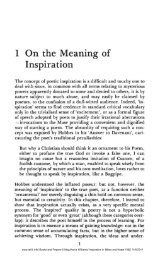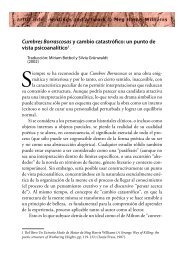Genesis of the 'aesthetic conflict' by Meg Harris Williams ... - Artlit
Genesis of the 'aesthetic conflict' by Meg Harris Williams ... - Artlit
Genesis of the 'aesthetic conflict' by Meg Harris Williams ... - Artlit
Create successful ePaper yourself
Turn your PDF publications into a flip-book with our unique Google optimized e-Paper software.
29/01/2012<strong>of</strong> language, and <strong>the</strong> nature <strong>of</strong> aes<strong>the</strong>tic appreciation as explored in particular <strong>by</strong>Adrian Stokes. Meltzer (though not himself a poetry-reader) was very well-readin linguistics and his preoccupation with symbol-formation is evident in DreamLife (1983) and Studies in Extended Metapsychology (1986), and in somelater papers. The influence <strong>of</strong> <strong>the</strong> major poet-philosophers such as Shakespeare,Milton and <strong>the</strong> Romantic poets on <strong>the</strong> psychoanalytic model <strong>of</strong> <strong>the</strong> mind I havedescribed in detail in o<strong>the</strong>r books (The Chamber <strong>of</strong> Maiden Thought, The Vale<strong>of</strong> Soulmaking); thinkers such as <strong>the</strong>se wrote poetry because (as Bion said) itwas ‘<strong>the</strong> most serious way <strong>of</strong> writing’. The essay on Hamlet, ‘The undiscover’dcountry: <strong>the</strong> shape <strong>of</strong> <strong>the</strong> aes<strong>the</strong>tic conflict in Hamlet’, was written for this bookat Meltzer’s request. The poetry analysis that originally went into <strong>the</strong> formation <strong>of</strong>‘aes<strong>the</strong>tic conflict’ however was my doctoral dissertation work from <strong>the</strong> 1970’s onInspiration in Milton and Keats, which became my first book (1982).Both Milton and Keats are exceptionally direct, explicit and sensuous in<strong>the</strong>ir depiction <strong>of</strong> <strong>the</strong> Muse (internal object). The link with <strong>the</strong> infant’s love-hateresponse to <strong>the</strong> mo<strong>the</strong>r’s ambiguity became clear, as did <strong>the</strong> idea <strong>of</strong> <strong>the</strong> combinedobject lying behind all o<strong>the</strong>r symbols (and <strong>the</strong> creative artist’s sense <strong>of</strong> service to it,on behalf <strong>of</strong> humanity); also <strong>the</strong> drive for knowledge and awareness <strong>of</strong> <strong>the</strong> pitfalls<strong>of</strong> false knowledge. Words as signs are liable to be an invention <strong>of</strong> <strong>the</strong> poet’s ego(Bion’s ‘lies’), a manipulation or even a claustrum. By contrast, exploration anddiscovery take place under <strong>the</strong> aegis <strong>of</strong> <strong>the</strong> Muse or object. The task <strong>of</strong> <strong>the</strong> poet isto create <strong>the</strong> container, <strong>the</strong> apparatus for receiving thoughts – <strong>the</strong> ‘wreathèd trellis<strong>of</strong> a working brain’ as Keats described it.This information about <strong>the</strong> poets’ model <strong>of</strong> <strong>the</strong> mind was not derived fromwhat is usually termed ‘psychoanalytic criticism’ – imposing an interpretive schemein a way that (as Bion says) ‘victimises’ literature. Ra<strong>the</strong>r, it arose from a mode <strong>of</strong>reading which has analogies with <strong>the</strong> way <strong>the</strong> transference works in <strong>the</strong> psychoanalyticprocess.The mode <strong>of</strong> reading that has an organic ra<strong>the</strong>r than a reductive relationshipwith psychoanalysis is founded on a syn<strong>the</strong>sis <strong>of</strong> two methodologies which aresometimes seen as contradictory. On <strong>the</strong> one hand, it requires <strong>the</strong> kind <strong>of</strong> techniquesfor analysing poetic diction that I. A. Richards formalised in <strong>the</strong> Cambridgeschool <strong>of</strong> ‘Practical Criticism’ – techniques <strong>of</strong> ‘close reading’; and on <strong>the</strong> o<strong>the</strong>r,it also depends on a‘reader-response’ or ‘New Critical’ awareness <strong>of</strong> <strong>the</strong> reader’ssubjectivity as developed in <strong>the</strong> American schools <strong>of</strong> literature. Ultimately, thissyn<strong>the</strong>sis goes back to Coleridge, whose philosophy <strong>of</strong> symbol-formation madeexplicit how in poetry, <strong>the</strong> objective and subjective fuse at <strong>the</strong> moment <strong>of</strong> knowledge.Meltzer summarised <strong>the</strong> need to join psychological and structural approachesin a note he wrote for <strong>the</strong> jacket cover <strong>of</strong> Inspiration in Milton and Keats:www.harris-meltzer-trust.org.uk/ papers © <strong>the</strong> author 2










